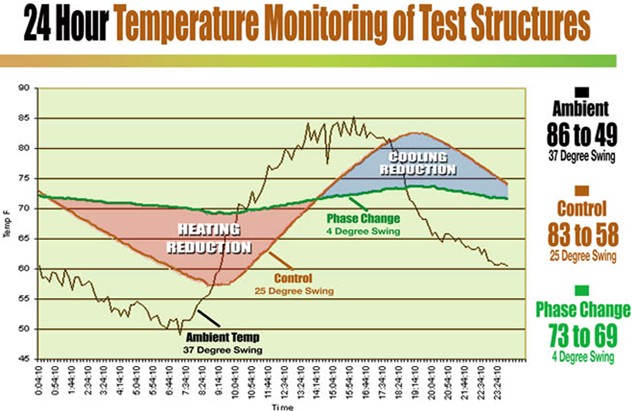What would you think of a building material that could go into nearly every new building and many remodels invisibly, indistinguishably replacing a material that currently goes into nearly all of them, and reduce heating and cooling demand for possible energy savings of 30% in most temperate climates?
And how frustrating would it be if this product had been in use in Europe for twelve years, and in place in demo houses in the US for a year, and still wasn’t on the market?
I’m talking about phase-change sheetrock. The second-largest U.S. gypsum wallboard manufacturer, National Gypsum, makes it under the name ThermalCORE and started showing it off at expositions in 2009. They gave it a nice Web page, which says, “Although not commercially available, ThermalCORE is being field tested….”

This is ordinary-looking half-inch gypsum sheetrock, sheathed in fiberglass rather than paper, with tiny beads of acrylic-coated paraffin mixed in with the gypsum crystals. Different melting points may be ideal for different climates and applications, but current ThermalCORE uses a 73 F. melting point. (Of the paraffin, not the panel as a whole.) As temperature rises past 73 degrees, the wax melts, and that change of phase (i.e., from solid to liquid) consumes heat, turning into “latent heat.” That means that the sheetrock gets cooler, and cools the air next to it, but will inevitably do the opposite—will warm up and give off exactly the same amount of heat it consumed—when things cool off again and the wax turns solid.
In this way your half-inch of sheetrock performs basically the same “thermal mass” temperature-moderating service as a five-inch brick wall. Without a single moving part, it cools your house as it’s getting hot, and warms it as it’s getting cold.
Note that it only works when your indoor air crosses that 73 degree mark. If it’s a heat wave in Atlanta, and the nights are so hot that nothing’s going to get your indoor air down to 72, ThermalCORE stopped helping after you passed 75 on the way up. Or if you want to save energy in your passive house in Portland by keeping your thermostat at 65 degrees, your ThermalCORE will help you with summer cooling but not so much with winter heating except on those rare sunny days. You’re stuck with the melting point of the stuff when the builder installed it. So we’d like this product not only to arrive commercially, but to be made in several different grades.
BASF has an animated graph showing potential energy savings in six different European cities, and in London (the one most similar to Portland) there were greater savings in cooling than heating needs. BASF manufactures the wax capsules (brand name Micronal) used in ThermalCORE, and several manufactures make products with it there, including a “smart” clay-based sheetrock.
If I were to hazard a guess at what’s holding things up, it would be the flammability of the paraffin, or the cost/benefit ratio. Paraffins are not terribly expensive, so I would hope effective prices are possible once sufficient production volume is reached. That can be a serious catch. When introduced, it may actually be more expensive that its counterpart in bricks. Inordinate fear of building fires has caused Americans to poison themselves with flame retardants as well as to forgo some promising building materials.
Meanwhile, we do have phase-change materials (PCM) available to put into our walls. BioPCMat consists of 16-inch-wide rolls of what looks like bubble-wrap with palm/soy oil blends in the bubbles. These are tacked up between studs, in the same way as insulation batts. BioPCMat incorporates a fire suppressant layer, and comes in three grades for different buildings and climates. The concept may not be as tidy as substituting for sheetrock, but it may prove to be a better application of PCM.